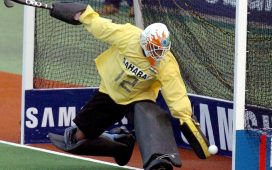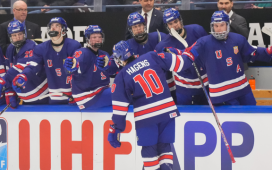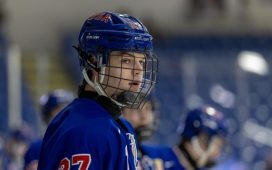Already facing a class-action lawsuit over not paying its players a minimum wage, the three major junior leagues that make up the Canadian Hockey League could soon find themselves facing a concussion lawsuit that could include hundreds, if not thousands, of former frequent fighters in junior hockey.
What started as a lawsuit launched against the CHL, the WHL and Hockey Canada by former WHL player James McEwan in January 2019 was recently re-filed with the Supreme Court of British Columbia to include both the OHL and QMJHL. Six days after the lawsuit was re-filed, the QMJHL postponed a vote on whether or not to ban fighting, a vote that was scheduled for that day, but was moved to August.
“It’s going across the country,” said Robyn Wishart, a lawyer with Wishart Brain & Spine Law whose firm is representing McEwan in his case. “It’s a pretty disturbing fact scenario. We’re not talking about incidental conduct. We’re talking about bare-knuckle fighting, permitted bare-knuckle minors fighting. It’s a very specific issue.”
In order for the lawsuit to become a class-action lawsuit, it must be certified, which is the next step in the process. The preliminary discussions in that will be held in Vancouver, likely in late March. Madam Justice Neena Sharma of the Supreme Court of British Columbia is presiding over the matter.
And the potential size of the class is mind-boggling, given it hopes to make anyone who played in one of the three leagues from the start of the 1974-75 eligible to join the lawsuit. The lawsuit is being brought forth by McEwan, who played four seasons for the Seattle Thunderbirds and Kelowna Rockets from 2004-05 through 2007-08, during which time he was involved in 72 fights. The lawsuit alleges that McEwan lost consciousness on the ice or after a fight, “on several occasions,” and that his fighting in junior led to surgeries, broken bones and escalating trauma to his head. “His anxiety, depression, mood swings, confusion and suicidal thoughts escalated, leading to what he describes as ‘manic behavior’ and symptoms of Chronic Traumatic Encephalopathy (CTE),” the lawsuit alleges.
Wishart said the proposed class action is open to any players, but geared more toward players such as McEwan, who had a defined role as a fighter/enforcer on his teams. When you’re talking about 45 years’ worth of players and thousands of fights per season across the three leagues, that could include a huge number of players. Wishart would not speculate on how many players might be involved.
Among many other things, the lawsuit alleges that the defendants’ approach to rules regarding fighting, violence and injury prevention is deficient in at least five respects:
• The leagues don’t take a preventative approach to fighting and violence by requiring fights be stopped immediately. “Rather, the approach the Defendants have long taken is to let fights happen, allow opposing players to beat each other senseless, and only address the consequences of the fight after the fact,” it alleges.
• The rules for fighting are not sufficient at the major junior level. “After a short trip to the penalty box, the offending players remain in the game, on the team, in the season and in the league. This is an insufficient deterrent,” it alleges.
• The lawsuit also alleges none of the leagues has, “responded to fighting as an injury event by establishing proper rules and protocols requiring that players who have just engaged in a fight are immediately sent for proper medical attention and follow-up.”
• The leagues have allegedly failed to even periodically address their rules to reduce injuries and have failed to properly track outcomes for their players.
• The three leagues have not instituted proper training for players, coaches and on-ice officials to make it clear fighting will not be tolerated, “and to end a culture within the league that has supported fighting and violence,” it alleges.
Much of the underpinning behind the proposed class has to do with a report prepared for the Ontario Ministry of Community and Social Services by William McMurtry entitled, Investigation and Inquiry into Violence in Amateur Hockey, which was dated Aug. 21, 1974, which is the cutoff date for the potential class. The report said, “There is absolutely no reason that fighting, attempts to intimidate, or using a stick to hurt or intimidate should be tolerated at any time, under any circumstances in hockey, particularly amateur hockey. Nothing short of a misconduct will be effective in this area. The sooner steps are taken to see that fighting, intimidation and provocation of an opponent are no longer ‘part of the game,’ the healthier hockey will be.”
The lawsuit is essentially seeking the past and future costs of health care services for the players involved and, “such further and other relief as this Honorable Court may deem just and meet.”
“It’s disturbing that these are children, by definition, who are bare-knuckle fighting,” Wishart said. “It’s something that needs to be looked at for sure. It’s really disappointing, so we’re going to try to affect some change. That’s the goal.”
Want more in-depth features and analysis? Subscribe to The Hockey News magazine.








